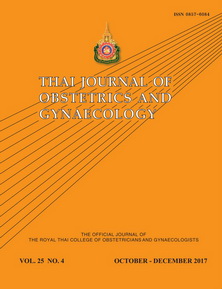Contraceptive Knowledge, Attitude and Behavior of Contraception in Teenage Pregnancy at Buddhachinaraj Phitsanulok Hospital
Main Article Content
Abstract
Objectives: To assess characteristics, knowledge, attitude and behavior in contraception among pregnant teenagers.
Materials and Methods: The cross-sectional descriptive study was conducted from September 2015 to February 2016 in pregnant teenagers (under 20-year-old) attending ANC or admitted at Buddhachinaraj Phitsanulok Hospital. The questionnaires consisted of general characteristics, contraceptive behavior, contraceptive knowledge, and contraceptive attitude. The data was analyzed using descriptive statistics, Chi square test and Spearman’s rank-order correlation.
Results: Three hundred and fifty pregnant teenagers were divided into two groups by using contraceptive knowledge mean scores (14.68). The above mean group (group A) composed of 192 teenagers (54.86%) and the below mean group (group B) had 158 teenagers (45.14%). There were significant differences in educational level (p = 0.033), gravidity (p = 0.006) and contraceptive attitude (p < 0.05) between groups. The two most common contraceptive methods were oral contraceptive pills (OCP) (66.86%) and condoms (30.29%) but the future choices will be depot medroxyprogesterone acetate (DMPA) (51.71%) and OCP (28.57%). The main sources of contraceptive knowledge were internet and school. If they had any problems, they asked their friends (47.14%) and used the internet (45.14%).
Conclusion: About a half of pregnant teenagers had contraceptive knowledge scores above mean. There was a significant difference in level of education, gravidity, and attitude between the two groups. The most common contraceptive method previously used was OCP but future contraceptive choice will be DMPA.
Keywords: contraceptive knowledge, attitude, behavior, teenage pregnancy
Article Details
References
2. UNICEF Thailand. Terms of reference for situational analysis of adolescent pregnancy. Sitan: [Adolescent Pregnancy]; 2013
3. Reuters News Report citing Bureau of Reproductive Health, Ministry of Public Health. http://news.yahoo.com/thailand-struggles-curb-high-teen-pregnancy-rate-045312739.html. Accessed March 27, 2013.
4. Areemit R, Thinkhamrop J, Kosuwon P, Kiatchoosakun P, Sutra S, Thepsuthammarat K. Adolescent pregnancy: Thailand’s National Agenda. J Med Assoc Thai 2012; 95:S134-42.
5. Sedgh G, Finer LB, Bankole A, Eilers MA, Singh S. Adolescent pregnancy, birth, and abortion rates across countries: levels and recent trends. J Adolesc Health 2014;56:223-30.
6. Kahn JG, Brindis CD, Glei DA. Pregnancies averted among U.S. teenagers by the use of contraceptives. Fam Plan Perspect 1999;31:29-34.
7. Chandra-Mouli V, McCarraher DR, Phillips SJ, Williamson NE, Hainsworth G. Contraception for adolescents in low and middle income countries: needs, barriers, and access. Reprod Health 2014;11:1-8.
8. Mung’ong’o SG, Mugyela V, Kimaro B. Knowledge, attitude and practice on contraceptive use among secondary school students in Dar es Salaam, Tanzania. East Central African J Pharm Sciences 2010;13:43-9.
9. Hemachandra A, Rungruxsirivorn T, Taneepanichskul S, Pruksananonda K. KAP Study on contraception in teenage pregnancy at antenatal care clinic and delivery room in Chulalongkorn Memorial Hospital. Thai J Obstet Gynaecol 2006;18:154-64.
10. Onyensoh O, Govender I, Tumbo J. Knowledge of, attitudes towards, and practices of contraception in high school pupils in Tswaing subdistrict, North West province. South Afri J Epidemiol Infect 2013;28:227-32.
11. Magnani RJ, Gaffikin L, de Aquino EM, Seiber EE, Almeida MC, Lipovsek V. Impact of an integrated adolescent reproductive health program in Brazil. Stud Fam Plan 2001;32:230e-43e.
12. Pulerwitz J, Barker G. Promoting healthy relationships and HIV’STI prevention for young men: positive findings from an intervention study in Brazil. New York: Population Council 2004:1-10.
13. Conde-Agudelo A, Rosas-Bermúdez A, Kafury-Goeta AC. Birth spacing and risk of adverse perinatal outcomes:a meta-analysis. JAMA 2006;295:1809-23.
14. Fengxue Y, Isaranurug S, Nanthamongkolchai S, Wongsawass S. Attitudes toward adolescent pregnancy, induced abortion and supporting health services among high school students in Phuttamonthon district, Nakhon Pathom province, Thailand. J Pub Health Dev 2003;1:25-32.
15. Brückner H, Martin A, Bearman PS. Ambivalence and pregnancy: adolescents’ attitudes, contraceptive use and pregnancy. Perspect Sexual Reprod Health 2004;36:248-57.
16. Jones J, Mosher W, Daniels K. Current contraceptive use in the United States, 2006-2010, and changes in the patterns of use since, 1995. National Health Statistics Report; No 60. Hyattsville, MD: National Center for Health Statistics 2012:1-26.
17. Amber Truehart, Amy Whitaker. Contraception for the Adolescent Patient. Obstet Gynecol Surv, Wolters Kluwer Health 2015;70:263-73.
18. Committee on Adolescent Health Care Long-Acting Reversible Contraception Working Group, The American College of Obstetricians and Gynecologists. Committee opinion no. 539: adolescents and long-acting reversible contraception: implants and intrauterine devices. Obstet Gynecol 2012;120:983-88.
19. Aggarwal O, Sharma AK, Chhabra P. A study in sexuality of medical college students in India. J Adolesc Health 2000;26:226-9.
20. Aggleton P, Campbell C. Working with young people: towards an agenda for sexual health. Sex Relationship Therapy 2000;15:283-96.
21. Eisenberg ME, Bernat DH, Bearinger LH, Resnick MD. Support for comprehensive sexuality education: perspectives from parents of school-age youth. J Adolesc Health 2008;42:352–9.
22. Lagus KA, Bernat DH, Bearinger LH, Resnick MD, Eisenberg ME. Parental perspectives on sources of sex information for young people. J Adolesc Health 2011;49:87-9.
23. Cavazos-Rehg PA, Krauss MJ, Spitznagel EL, Iguchi M, Schootman M, Cottler L, et al. Associations between sexuality education in schools and adolescent birthrates. Arch Pediatr Adolesc Med 2012;166:134-40.
24. Reena S, Kumar SD, Radha J, Kumkum S, Neela S, Sushmita S. Contraceptive knowledge attitude and practice (KAP) survey. J Obstet Gynecol India 2005;55:546-50.


